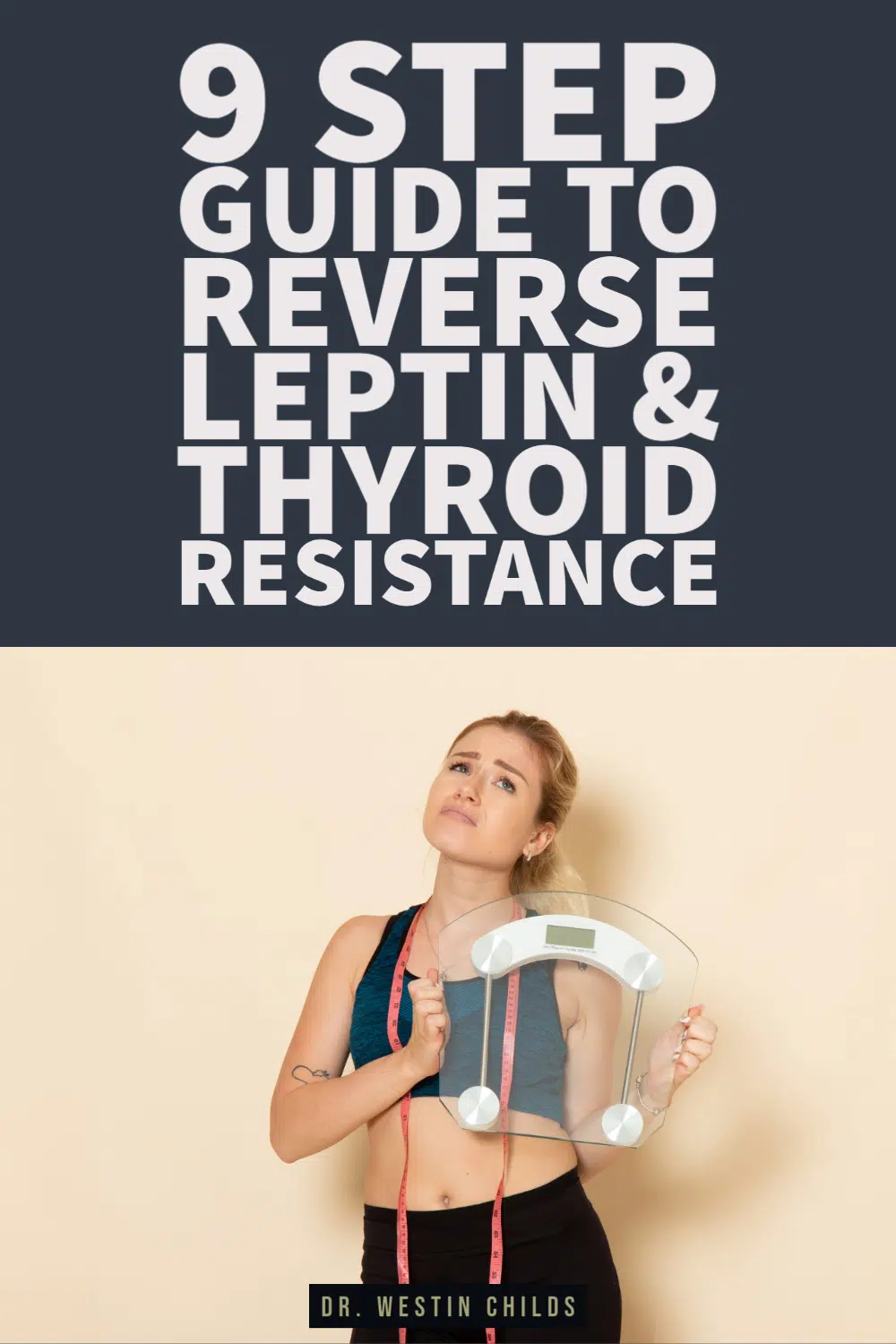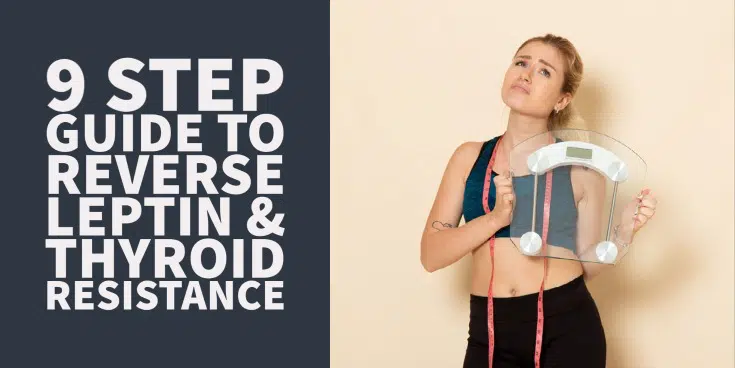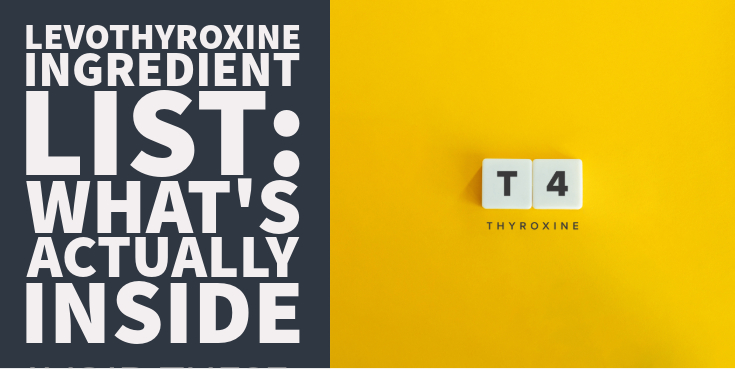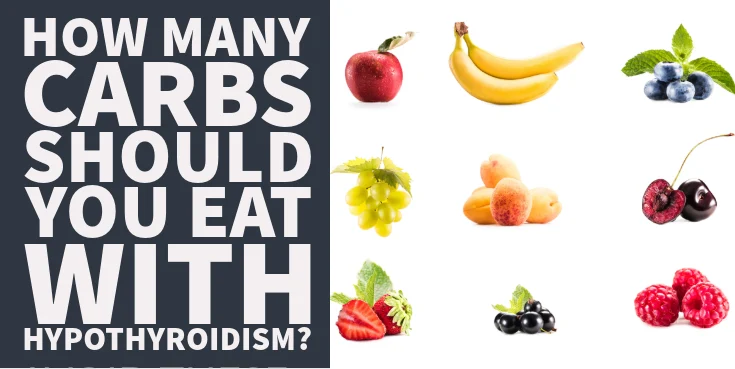Are you having trouble losing weight?
Or, better yet… do any of these sound familiar?
- You can’t lose weight no matter how much you exercise
- You are constantly gaining weight even though you haven’t changed your exercise or diet routine
- You feel like your metabolism is unusually slow or damaged
- You’ve tried 4+ different calorie-restricted diets in your life (weight watchers, HCG diet, etc.)
- You used to be able to lose weight by dieting but you can’t anymore
- You think you have thyroid problems but the Doctor keeps telling you everything is “normal”
If you fall into any of these categories you may be suffering from something known as Leptin resistance and/or Thyroid resistance.
Chances are this may be your first time hearing about Leptin resistance or Thyroid Resistance…
But don’t worry:
I’m going to explain everything – including how to diagnose, treat and manage both conditions.
Stay tuned…
DOWNLOAD FREE RESOURCES
Foods to Avoid if you Have Thyroid Problems:
I’ve found that these 10 foods cause the most problems for thyroid patients. Learn which foods you should avoid if you have thyroid disease of any type.
The Complete List of Thyroid Lab tests:
The list includes optimal ranges, normal ranges, and the complete list of tests you need to diagnose and manage thyroid disease correctly!
The Powerful Connection between Weight gain and Leptin Levels
So what is Leptin (1) anyway?
Leptin is a hormone that is pumped out by your fat cells (Yes, they do more than just give you cellulite).
Leptin has a specific action in the brain (it works on your hypothalamus) to control your metabolism and your appetite (2).
You see:
We evolved with leptin as a way for our fat cells to communicate with our brains. And we want this to happen (when it works correctly).
When we have a lot of food to eat (and fat stores are high), our body is supposed to tell our brain to increase the metabolism of our body to start burning up that extra fuel.
So by now, you may be asking yourself…
If that’s the case, why does it feel like my metabolism is so low despite having a lot of excess fat in my body?
Shouldn’t my metabolism be high so that I can burn up this extra fat?
The truth is that you SHOULD be doing that and if you aren’t, then you may have the condition known as Leptin Resistance.
So let’s find out how that happens…
How do we get Leptin Resistance?
Leptin resistance is what happens when the entire system goes haywire, and it leads to some pretty unfavorable changes in the body.
As you gain more and more fat cells, your leptin levels continue to increase in the blood.
This is your body attempting to tell your brain to increase metabolism and slow down your appetite to help burn that extra fat.

Eventually, your brain becomes “numb” to the signal and starts to tune out the leptin that it sees. Over time your brain completely blocks out any leptin in the system.
This process is similar to what occurs in the condition known as insulin resistance and type II diabetes.
And that’s when the symptoms kick in…
Once your brain tunes out the leptin it starts to think your body is in a state of starvation. So your brain slows down the metabolism of your entire body and increases your appetite to try and compensate.
So instead of burning the extra calories you just ate, your body stores it all as fat and INCREASES your appetite in the process (3).
This ultimately leads to more weight gain and higher leptin levels making the cycle even worse.
Signs and Symptoms of Leptin Resistance
Most people who suffer from Leptin Resistance know that something is wrong with their bodies.
They watch other people eating food, not exercising, or living an unhealthy life without gaining weight or changing their body type.
Meanwhile, patients with leptin resistance will gain weight if they don’t follow a STRICT diet.
Many patients with leptin resistance eat a calorie-restricted diet simply to maintain their weight (this has to do with the metabolic damage that accompanies leptin resistance which we will discuss later).
Even eating something like potatoes or white rice can cause weight gain in these individuals.
Now we know what it is, we need to talk about how to diagnose it.
Patients with leptin resistance tend to experience at least 2 of the following symptoms:
- Inability to lose weight despite eating a calorie-restricted diet and exercising regularly
- Constant weight gain is usually accompanied by a ravenous appetite
- Constant food cravings, even after eating a large meal
- Constant fatigue, low energy, or feeling “sluggish”
- Cold body temperature(defined as less than 98.0 degrees F)
- Low resting heart rate(defined as 50-60 first thing in the morning assuming that you are both overweight and not aerobically conditioned)
- Worsening symptoms of hypothyroidism (Hypothyroidism frequently accompanies leptin resistance)
These are what I call the “warning” signs of Leptin resistance.
They don’t necessarily mean you have it, but if you are suffering from more than 2 of the symptoms above then there is a high chance you might be.
The presence of these symptoms should trigger the next step, which is serum blood testing.
How to Diagnose Leptin Resistance
If you want a definitive answer, then you’re going to have to get some lab tests (and you will have to ask your Doctor to order these or order them yourself online).
The absolute best way to diagnose Leptin Resistance is by checking a fasting serum Leptin Level.
Your Serum Leptin level should be less than 10-12.
If your fasting serum leptin level is greater than 10-12 and you are at least 20 pounds overweight this is an indication that you have leptin resistance.
Why?
Because the fact that leptin levels remain elevated in the face of obesity is a clear signal that the normal feedback loop is dysregulated.
You can see an example of a patient with leptin resistance and her labs below:

In this result, her fasting leptin level is 48.2 (note that there is no reference range for leptin levels).
It’s important to realize that most physicians don’t understand the significance or importance of leptin levels as they related to weight gain and weight loss.
As a result, you may need to be asking for these tests and read posts like this to evaluate your lab result.
Please also note that the lab will try to give you an approximate range for leptin levels based on your BMI.
This may erroneously lead you to believe that your leptin level is somehow “normal” because it falls within the specified range.
Believe me, this is not the case.
The lab makes observations about lab tests and notes that, for instance, patients with a BMI over 40 tend to have a leptin level > 30.

But this does NOT mean that it is normal, it just means that there are many others out there with leptin resistance.
Other lab tests to evaluate leptin and metabolism
In addition to checking serum leptin levels, I also recommend checking serum uric acid levels (4).
Uric acid levels act as a proxy for determining how well your body is metabolizing fructose. And fructose combined with a high-fat diet (5) can make leptin resistance worse.

So it’s worth looking at your liver to see how well you are metabolizing fructose.
If Uric acid levels are > 5 then you know you are consuming too much fructose for your body or your liver is having difficulty metabolizing the fructose. (This is also my secret weapon for determining if my patients are telling me the truth about their diet).
I like to see uric acid levels < 5 and Leptin levels < 12.
The last test I like to order is Reverse T3.
As leptin increases and your metabolism slows, your Reverse T3 level will increase.
This is a compensatory reaction.
Thyroid hormone is responsible for a large portion of your metabolism at baseline.
So as leptin levels rise and you develop leptin resistance, your hypothalamus lowers your basal metabolic rate.
Reverse T3 acts as a brake for your metabolism, so as leptin levels rise your reverse T3 will also rise – thus damaging and further slowing your metabolism.
This connection is explained further in this study (6).
I use 15 as a cut-off for Reverse T3. Anything higher than that indicates to me that there is a problem with thyroid conversion and likely metabolism.
It’s not uncommon for me to see patients with Reverse T3 levels in the mid-20s, especially if they have a history of yo-yo dieting or calorie-restricted dieting (like the HCG diet).
If your levels are out of range then you are suffering from Leptin resistance and most likely Thyroid resistance (which we will talk about below).
- Bottom line: To evaluate your body for leptin resistance make sure to check these lab tests: Fasting serum leptin level, serum uric acid and reverse T3. You will have to ask your doctor for these tests.
Leptin Resistance causes Thyroid Resistance
Aside from the fact that Leptin Resistance makes it almost impossible to lose weight, it also causes further issues with your thyroid gland.
As Leptin levels increase and your brain slows down your metabolism, your body will start to convert Free T4 into Reverse T3 (7).
Reverse T3 actually competes with your cells for binding with the free and active T3 hormone.

The higher your reverse T3 levels, the lower your metabolism and the more likely you are to suffer from hypothyroidism (8).
This increase in Reverse T3 is known as “Reverse T3 pooling”.
It’s also clinically seen as euthyroid sick syndrome or Low T3 syndrome. (I’ve outlined the connection between these conditions in the other blog posts)
Treating these high levels of reverse T3 can be a tricky process and requires a physician who is knowledgeable in both leptin resistance and reverse T3.
Often times the best treatment for patients with this condition is T3-only medication.
In addition, you may require a total reduction in your T4 thyroid medication to reduce the conversion of T4 to reverse T3.
This connection between leptin, obesity and thyroid hormone is very powerful.
In many cases, it’s hard to determine which condition came first considering that they all can worsen each other.
Because of this, it’s best to start with a comprehensive lab panel that includes testing beyond the leptin levels mentioned above.
If you think you might be suffering from Hypothyroidism get your levels checked.
I recommend testing for the following thyroid tests (at baseline):
- TSH: This test is highly inaccurate the higher your leptin levels get. But in general healthy levels (assuming you aren’t already on medication) is less than 1.0.
- Free T3: Should be in the upper 1/2 of the reference range (assuming you aren’t taking thyroid medication)
- Free T4: Less important than T3, but gives you an idea about T4 to T3 conversion.
- Reverse T3: Should be less than 15.
- Total T3: Should be in the upper 1/2 of the reference range.
- Antithyroid antibodies: As low as possible.
- Sex hormone binding globulin: 20-30 in men and 60-70 in women (assuming you aren’t on birth control or other oral estrogens). This gives you an estimation of tissue levels of thyroid hormone in the liver.
(Make sure that you evaluate your levels with the “optimal range” and not just the “normal range” in mind – please see the link above for further details.)
One of the most frustrating parts of diagnosing and managing Thyroid resistance with Leptin resistance is that your thyroid lab tests may always show up as “normal”.
In fact, your Doctor isn’t likely to even order the tests that you need to diagnose the condition unless you ask for them.
But there’s more:
When reverse T3 levels increase in the blood, your body will naturally have higher levels of Free T3 as well.
This can fool you into thinking that your thyroid function is “normal” or that your body is converting Free T4 into Free T3 – but that is NOT the case.
The pattern I typically see in leptin resistance and thyroid resistance looks like this:
- Low levels of Free T4
- Mid-high levels of Free T3
- High levels of Reverse T3
- Low-normal levels of TSH
Even Doctors who order the right tests can be fooled by those numbers, but the reality is that patients with this lab pattern need more thyroid hormone (preferably T3) not LESS.
Don’t assume that just by ordering these tests that you will get proper treatment either, your physician must understand the importance of these hormones and lab tests in order for you to get the right treatment (elaboration below).
How to treat and Reverse both Leptin Resistance and Thyroid Resistance
So now comes the most important part:
If you have Leptin Resistance what are you supposed to do about it?
Treating and reversing leptin resistance can be tricky, but it’s not impossible.
In my experience, most patients will need to do a combination of therapies to get the best results possible.
Doing just one thing at a time isn’t likely to produce results.
This philosophy runs counter to the current treatment paradigm that most patients and physicians like to follow – treat one variable at a time and evaluate.
It took various insults to get you to where you are now (diet, stress, lifestyle, hormone imbalances, etc.) and it will require multiple therapies to reverse the process.
Note: these tips are not necessarily in order of importance or efficacy.
#1. Get on the right type and dose of thyroid hormone
This step is very important for treating and reversing leptin resistance.
Many patients stand to benefit from the addition of T3 thyroid hormone in the form of Cytomel, liothyronine, or sustained release T3.
The reason T3 is so effective is that part of the problem with leptin resistance is that it causes T4 to reverse T3 conversion.
It’s important to under this point:
T4 is required for conversion to reverse T3.
If you remove T4 from the body then you won’t have the substrate to produce reverse T3 from.
Make sense?
And this is exactly what taking T3 does.
You can bypass this conversion step so you “force” your T3 levels higher while simultaneously reducing your reverse T3 levels.
If you are already taking T4 medication this might mean a reduction in your T4 dose.
This can sometimes, paradoxically, improve your thyroid function by reducing the T4 substrate.
This is also true of patients taking Natural Desiccated Thyroid hormone.
Even though NDT does contain some T3, it’s still mostly T4 thyroid hormone.
So reducing your dose of NDT may be necessary to reduce reverse T3 levels and help reduce leptin levels.
- Bottom line: Adding T3 thyroid hormone in the form of Liothyronine or Cytomel can help reduce your reverse T3 levels, increase your metabolism and improve energy levels. This is a critical component of reversing leptin resistance.
#2. Optimize your exercise routine and do the right kind of exercises
When it comes to exercising, not all exercises are created equal.
In addition, many patients are actually overtraining and may be making it more difficult to lose weight.
Over-training leads to higher than normal cortisol levels which may alter insulin levels and ultimately make weight loss more difficult.
If you have known leptin resistance then you will find the most benefit in doing high-intensity interval training.
HIIT has been shown to help reduce leptin levels (9) long-term (note this effect may take months).
But there’s a catch:
You need to make sure that you are doing enough to help lower the leptin levels, but not enough to cause issues with cortisol.
It may also be difficult to add in exercise due to the fatigue that often accompanies leptin resistance from reduced mitochondrial energy production.
With these variables in mind, it’s best to start off slow with 1 session of 10-30 minutes per week and increase your exercise frequency and intensity as tolerated.
- Bottom line: Adding high-intensity exercise can help reduce insulin and leptin levels and help with weight loss. Just make sure you aren’t over-exercising which can make weight loss more difficult.
#3. Optimize your diet
Changing your diet is critical for lowering leptin levels.
There are multiple considerations (we will go over the others below) but for this section, we want to focus on reducing inflammation with your diet.
We know that the standard American diet (10) is full of industrial seed oils and inflammatory omega-6 fatty acids (the hallmark of processed food).
The addition of these foods can promote inflammation which further increases leptin levels (11) and adds fuel to the fire.
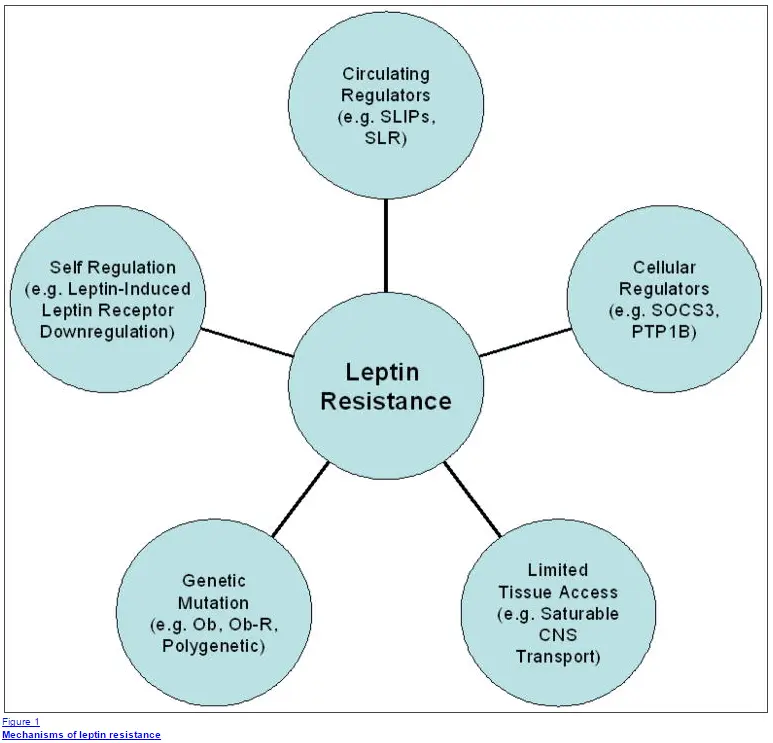
With this in mind is very important to remove all sources of processed foods, all sources containing industrial seed oils, and to eat a whole food diet.
True – this change in your diet by itself will be necessary for reducing your leptin level, but it will not be enough by itself to reverse the condition.
If you have no idea where to start remember that changing your diet is easy as adding in real sources of whole food.
I call this the one-ingredient diet.
Meaning you only eat foods with one ingredient (apples, bananas, almonds, etc.).
This is a very simple and clear way to dramatically improve your health.
You can also find more resources here:
- Whole 30 diet
- Anti-inflammatory diet
- My dietary recommendations and weight loss program
- Bottom line: Changing your diet will be necessary to reduce leptin levels but often will not be enough by itself for significant weight loss. Focus on natural whole food, and anti-inflammatory diets.
#4. Optimize your sleep (very important)
Sleep is one of the most overlooked factors when it comes to weight loss.
Lack of sleep is associated with an increase in insulin/blood sugar levels, and inflammation (12), and may increase leptin levels and leptin resistance (13).
While improving your sleep may not help you lose weight by itself, what it does is still very powerful.
Getting at least 8 hours of sleep will help increase the velocity of your weight loss over time.
Lack of sleep can also reduce how much weight you lose.
For instance:
Let’s say you would have lost 10 pounds in a month following my weight loss recommendations, however, if you don’t manage your sleep well you may only lose 5 pounds.
This is generally how sleep interacts with weight loss.
Fortunately, improving your sleep isn’t very difficult and you can start with some basic recommendations and ramp up the intensity as necessary.
Start with these supplements:
- 5 HTP: 5-HTP is a serotonin precursor and can naturally help calm you down before bedtime. This is especially helpful if you are also suffering from depression or other mood disorders. Use 50-100mg per night (1 hour prior to bedtime).
- Melatonin: Melatonin can help promote a regular circadian rhythm. Start with dosing between 1-3mg and take it approximately 30-60 minutes prior to bedtime.
- GABA + Serotonin potentiators: These supplements help promote natural neurotransmitters in the brain (GABA + serotonin) which help calm down the brain and induce regular sleep patterns. Take 1 capsule each night 30-60 minutes prior to bedtime.
- Bottom line: Improving your sleep will be necessary to lower your leptin levels if you are sleeping less than 8 hours per night. The addition of supplements can help to improve both the depth and quality of your sleep.
#5. Reduce your protein consumption
If you have leptin resistance you will also need to make some dietary changes beyond what we’ve already discussed.
It turns out that protein stimulates the release of leptin.
In the case of protein, this occurs primarily through signaling pathways with mTOR.
This is very important because the “standard” and “conventional” weight loss advice often includes copious amounts of lean protein.
Eating lean protein with every meal (or adding protein powder) can influence your leptin levels through this interaction with mTOR (14).
mTOR is involved in cellular signaling and sends the signal of growth.
That means growth for your fat tissues, obviously something you don’t want if you have leptin resistance.
For more detail on how to incorporate this style of eating into your diet, you can check out this article about the leptin diet.
- Bottom line: Reducing both fructose and your overall protein intake can help reduce leptin levels and should be incorporated into your dietary strategy.
#6. Stop limiting your calories and/or stop calorie-restricted dieting
This is both a very important step and also a tough step for many patients.
Naturally many patients with leptin resistance find that by reducing their calorie count they are able to maintain their current weight.
Unfortunately, this cycle of calorie restriction leads to a metabolic adaptation that results in a lower metabolism, high reverse T3 levels, and even higher leptin levels.
Put another way you are making the problem even worse.
This can be difficult for many patients because they know that increasing their food consumption will result in some weight gain, but it WILL be necessary to heal your metabolism long term.
It has been clearly shown (15) that calorie restriction plus constant exercise results in a severely damaged metabolism long-term.
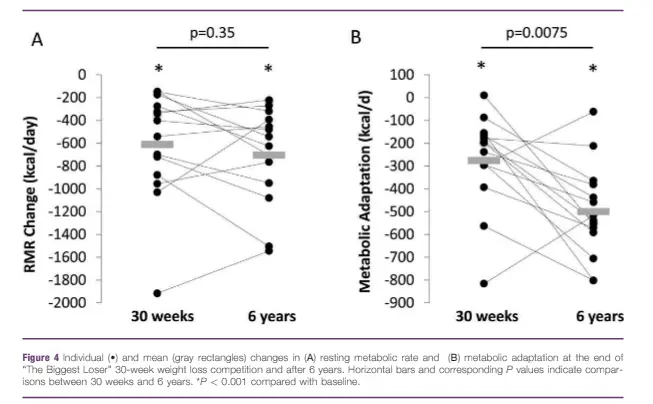
The image above shows the metabolism of the biggest loser contestants both during the program and 6 years after.
You can see that during the program their metabolism is damaged to the point that they are burning on average less than 600 calories than normal EACH day.
And, what’s even worse, is that this metabolic damage persists for 6+ years.
You can also see that 6 years later on average their metabolism is still damaged and they are burning on average 700 calories less than what is “normal”.
Imagine you would burn 2,000 calories normally but because of your dieting, you now burn 1,300 calories per day on average due to your damaged metabolism.
Naturally, you would eat 1,300 calories per match your energy expenditure just to AVOID weight gain.
These changes are real and clearly outlined, but unfortunately, many physicians and Doctors either don’t know about them or don’t appreciate them.
As a result, when you go to the doctor and tell them you’re eating 1,300 calories each day and you’re still overweight – they don’t believe you.
In order to break this cycle, you must slowly increase your food intake to heal your metabolism (but note this may take a very long time).
- Bottom line: Calorie restriction (defined as anything less than 1,500 calories per day) or any diet that is considered a “low calorie” diet will ultimately make your leptin resistance worse over time. In order to fix this problem, you must slowly fix your metabolism and increase your calorie consumption to match your energy output.
#7. Optimize T4 to T3 conversion
As you might recall it is very important to improve your T3 levels when treating leptin resistance.
One of the ways that you can do this naturally is by increasing your T4 to T3 conversion (which will necessarily reduce your T4 to reverse T3 conversion).
You can do this in many ways, but one of the best ways is by introducing certain supplements that have been shown to increase this conversion.
You can see all of the steps involved (and nutrients required) for proper thyroid hormone production, signaling, and conversion in this post here.
Here we will go over only those supplements that help conversion (which many people also happen to be deficient in):
- Zinc: Zinc helps to reduce inflammation, acts as a powerful anti-inflammatory agent, and can increase T4 to T3 conversion. Many people are deficient in zinc which makes supplementing a great option.
- Selenium: Selenium helps balance the immune system, reduces inflammation, and boosts T4 to T3 conversion naturally. Doses range from 75mcg to 150mcg per day.
- Bottom line: Using supplements to boost your thyroid conversion can help improve energy production, reduce leptin and increase thyroid function in the body.
#8. Reduce and treat high insulin levels if present
As you may already be aware your weight is a direct result of the hormone balance in your body.
This should be differentiated from the generic calorie in/calorie out model of weight loss.
Calories are important, but only in how they impact your hormones – not their caloric value necessarily.

For instance:
A diet high in refined carbs, sugars, bread, pasta, etc. will necessarily result in weight gain due to insulin resistance that develops as a result of this type of diet.
What you may not realize is that patients with leptin resistance generally have multiple hormone imbalances by the time they develop leptin resistance.
What this means for you is that you probably have leptin resistance in addition to other hormone imbalances in your body that need to be treated as well.
Leptin resistance and insulin resistance frequently come together as a package pair.
So if you have leptin resistance you should evaluate and treat insulin resistance if it is also present.
If you follow all of the steps outlined above (and below in the medication section) you will most likely be improving insulin resistance as well.
Having said that there are other things you can add to boost your weight loss results and lower both insulin and leptin levels.
You have insulin and blood sugar-related issues if your fasting insulin is greater than 5 (12 hours) and/or if your fasting blood sugar is greater than 90 (12 hours).
Both conditions represent abnormal glucose homeostasis.
And with a prevalence of about 50% of the US population, there is a good chance you are dealing with insulin resistance.
Consider these supplements to help lower your insulin and blood sugar levels:
- Sustained release alpha lipoic acid: ALA is a powerful antioxidant and helps reverse insulin resistance at the cellular level. For weight loss and a reduction in insulin levels, you will need doses as high as 1,800-2,400mg per day.
- Berberine: Berberine is another very powerful medication that can help reverse insulin resistance, help build muscle mass and improve energy production. Berberine has been shown to be as powerful as metformin in terms of reducing blood sugar and insulin levels but doses as high as 2,000mg per day may be necessary for this benefit.
- Sustained release curcumin: SR Curcumin has been shown to delay the onset of pre-diabetes to diabetes for at least 9 months. This powerful supplement helps reverse cellular inflammation and improves insulin sensitivity. Doses as high as 1,000mg per day may be necessary for this benefit.
- Bottom line: Insulin resistance contributes to obesity and often accompanies leptin resistance. Treating insulin and leptin often go hand in hand and must be treated concurrently.
#9. Consider the use of medications to manage insulin + leptin levels
This is where things get really interesting.
Leptin resistance is largely unknown to the medical community (even endocrinologists and many bariatric physicians), but this doesn’t mean that its incidence is growing.
Unfortunately, this means that getting help for your condition from your doctor may be difficult.
Having said that, there are a few medications that have been shown to dramatically reduce leptin levels and lead to significant weight loss on their own.
The best part about these medications is that they can be used to augment your results and don’t necessarily need to be maintained long-term.
They should, however, not be used alone.
Do not make this mistake.
The combination of medications + hormones + supplements + all of the other steps above will lead to the BEST results.
The medication referenced above includes the class known as GLP-1 agonists.
GLP-1 agonists have been shown to do several things ALL of which are beneficial to the patient with insulin and leptin resistance.
First:
They directly reduce leptin levels (16).

Second:
These medications help with weight loss if used by themselves in patients without diabetes or pre-diabetes (17).
These medications are approved for the treatment of type II diabetes, but they have special effects on patients without this condition.
Studies have shown that non-diabetic patients can benefit from the weight loss effects of these medications.
Third:
GLP-1 agonists REDUCE the rise in leptin levels (18) that often accompany rapid weight loss preventing weight gain long term.
One of the main reasons that patients gain weight after losing weight is due to the rise in leptin that occurs as a result of unhealthy weight loss.
The GLP-1 agonist medications can help reduce that rise in leptin and have been shown to help patients keep off their lost weight.
Fourth:
This group of medications also reduces insulin resistance and blood sugar (19).
As I mentioned previously, many of these therapies target both insulin and leptin resistance.
These medications do the same thing.
The fact that they target both leptin and insulin makes them very powerful when used in conjunction with the other recommendations listed above.
The trick in using GLP-1 agonists has to do with dosing. The standard recommended dosing doesn’t work very well and the medication must be adjusted for each individual in order to achieve optimal results.
- Bottom line: Some targeted medications can dramatically reduce leptin levels and help with weight loss. Many patients with leptin resistance will benefit from the addition of these medications.
Take home message
Leptin Resistance and Thyroid resistance are both serious conditions that can make losing weight almost impossible.
It’s a vicious cycle that results in a hormonal imbalance where your body thinks it’s starving leading to constant weight gain and a voracious appetite.
Unfortunately, it can be hard to diagnose and is missed by most Doctors.
Because of this, you will need to be your own advocate, check your symptoms, and start taking action with the steps provided at home.
Remember balancing Leptin, the “master hormone” of your body fat, is required if you want to ever have long-lasting weight loss.
If you have any of the symptoms listed above make sure to get your leptin levels (and other hormones) evaluated and use these tips to help with weight loss.
Now it’s your turn:
Have you been diagnosed with Leptin resistance or Thyroid resistance?
What has actually helped you to lose weight?
Have you tried T3-only medications for these conditions?
Leave a comment below!
Scientific References
#1. http://www.ncbi.nlm.nih.gov/pubmed/12403078
#2. http://www.ncbi.nlm.nih.gov/pubmed/17212793
#3. https://www.ncbi.nlm.nih.gov/pubmed/12403078
#4. https://www.ncbi.nlm.nih.gov/pmc/articles/PMC5409734/
#5. http://www.ncbi.nlm.nih.gov/pubmed/18703413
#6. https://www.ncbi.nlm.nih.gov/pmc/articles/PMC377492/
#7. http://www.ncbi.nlm.nih.gov/pmc/articles/PMC3608008/
#8. http://www.ncbi.nlm.nih.gov/pubmed/11086640
#9. http://ajcn.nutrition.org/content/73/2/240.full
#10. https://www.ncbi.nlm.nih.gov/pmc/articles/PMC4074336/
#11. https://www.ncbi.nlm.nih.gov/pmc/articles/PMC4556270/
#12. https://www.ncbi.nlm.nih.gov/pmc/articles/PMC3548567/
#13. https://www.ncbi.nlm.nih.gov/pubmed/15531540
#14. https://www.ncbi.nlm.nih.gov/pubmed/18583936
#15. http://onlinelibrary.wiley.com/doi/10.1002/oby.21538/epdf
#16. https://www.ncbi.nlm.nih.gov/pubmed/25287751
#17. https://www.ncbi.nlm.nih.gov/pubmed/24249759
#18. https://www.ncbi.nlm.nih.gov/pubmed/17130484
#19. https://www.ncbi.nlm.nih.gov/pmc/articles/PMC4792029/
